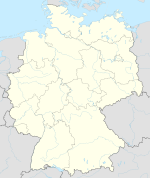Zwesten Castle
Coordinates: 51 ° 3 ′ 6 ″ N , 9 ° 10 ′ 23 ″ E
The Castle Zwesten is located on the southern outskirts of Bad Arolsen in northern Hesse Schwalm-Eder district , just south of the of Odershausen and Braunau coming Wälzebachs , which flows through the southern part of the town.
The attachment
It is a simple, elongated, two-storey classicist building made of plastered half-timbering with a flat triangular gable in the middle of the front. The building was erected in 1782 as a representative mansion by the Hesse-Kassel master hunter Wilhelm Treusch von Buttlar . After the addition of a classical porch with a balcony under the triangular gable in 1915, the building is called a castle . The castle stands at a height of about 200 m above sea level with the front facing east, pointing over the Löwensteiner Grund and the Schwalm valley to the 433 m high Altenburg , in the middle of a park extending to the south . Just north is at right angles to the castle which about 200 years old, built and half-timbered called Kavaliershaus , originally servants' quarters with barn and stables was.
history
The property was originally part of an agricultural estate belonging to the old Hessian noble family von Löwenstein , whose largest village was Zwesten for a long time, but in which they no longer had any property from 1774. The estate first came to the von Hanstein family through the marriage of Christine Hedwig von Löwenstein, daughter of Kaspar Bernhard von Löwenstein, with Bernhard Heinrich von Hanstein , then through purchase to Carl Reinhard Goddaeus, who bequeathed it to his sister Maria Amalia, the wife of the Hesse-Kassel Secret Council and Vice Chancellor Christian Heinrich von Motz (1687–1751). She sold it to the Waldeck landdrosten Florence Anton Heinrich Georg Philipp von Eppe zu Reckenberg , who died childless in 1785. His heirs sold it to Wilhelm Treusch von Buttlar, who had the manor house built in 1782. His marriage to Caroline of Lehrbach remained childless, and the plant came by inheritance in 1800 to the son of his sister Wilhelmine von Buttlar gen. Treusch (1720-1803), the later Hessian Lieutenant General and Governor of Kassel Wilhelm Georg Ludwig Casimir of and Urff (1753-1834), whose descendants, in particular the last owner of the Urff estate, Karl von Urff, sold a large part of the associated lands and forests by 1912. In 1913 one of the Treusch von Buttlar zu Brandenfels who had been raised to the baron status in 1811 during the time of the Kingdom of Westphalia acquired the manor house. He had the portico with a balcony added so that the building was called a castle from 1915.
Todays use
After the Second World War , the Buttlar no longer used the castle themselves. Baron Carl von Funck, the former district administrator of the Fritzlar-Homberg district , lived there until 1952 . Then it was bequeathed to the Kaufungen Knightly Abbey and used by them as a retirement home.
An important collection of European and East Asian works of art, compiled by the Treusch von Buttlar family, was in the palace until it was closed in 1963.
Today both the castle and the Kavaliershaus are privately owned. The castle is used as a residential complex and a dental clinic. In the Kavaliershaus, which has been renovated in accordance with monument protection guidelines, there is a hotel with a wellness facility.
literature
- Rolf Müller (Ed.): Palaces, castles, old walls. Published by the Hessendienst der Staatskanzlei, Wiesbaden 1990, ISBN 3-89214-017-0 , p. 388.
- Werner Ide, From Adorf to Zwesten. Local history pocket book for the Fritzlar-Homberg district. A. Bernecker Verlag, Melsungen, 1971, p. 431
- Marcus Cultivator among others: manors, palaces, castles and manors. Photographic walks between Schwalm, Eder, Fulda, Werra and Weser: mansions, palaces, castles & manors, volume 1. Verlag M. Faste, Kassel, 2003
Individual evidence
- ↑ cf. on www.schlossarchiv.de



